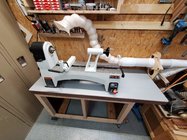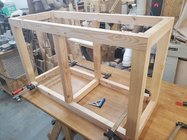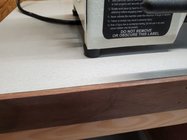As always, please help me understand how I might be going off the rails here. I'm new, and I'm probably going to be as wrong about these things as I ever will be.
I have a Harvey T40 on the way and not much of a place to put it yet. I did not order the legs, because on the day that I ordered, there were two discounts, and one was not optional. This was a much smaller amount than the lathe+leg package, unfortunately. Since I also wanted a bed extension, and it also had the smaller (but still appreciated) discount, I ordered that instead. I figured I could just build a bench, but building a bed extension is beyond my capabilities and tooling.
I think -- just a hunch -- that it would be ergonomically incorrect and downright dangerous to use it on the floor, so I need to build a bench. Vibration suppression is the leading requirement, trumping storage altogether bt not access to the machine, but there's no reason I cannot design in some storage. The eventual shop layout is also a factor, but can be ignored for now and I can design in enough flexibility that it can be deferred.
First, the top:
I think the bench top, at least, is going to be a concrete slab. Maybe I'll have some difficulty making it perfectly flat, but I am toying with the idea of picking up a piece of 1/4" or thicker plate steel at a scrap yard and using that for the surface. To do this, I will place it flat using shims or whatever necessary, then either frame it on the sides with wood or hopefully convince my welder to weld a band of plate either around the edge or just inset underneath so the top has a short edge, flip it over onto its top, and pour the slab into the box so that there is full contact between the steel and the concrete. This may still separate (cleave), so I will have to figure out some fastening strategy to bond the two disparate materials together. Even with studs and anchors welded to the underside of the plate, the two surfaces will probably still cleave. So I have to research some sort of bonding material, perhaps, or just create enough rough surface that there is full and permanent contact between the concrete bed and the steel top. If anyone has ideas or materials experience here, I'd like to hear it.
Support:
This is a good place to note that I have a concrete floor in my shop, so aside from portability considerations, I welcome all the extra weight I can get. I am forsaking a daily-use level of portability of the actual bench, however. That is, no wheels. I may need to move it someday, and maybe again some other day, so I will not anchor it to the floor permanently and it will still need to be (re)movable without requiring a jackhammer. Regardless of what I do, I am strongly considering boring a few holes into the concrete slab and installing some heavy tie-downs, cemented in.
The legs of the bench "don't matter". That is, they can be some short lengths of I-beam, or simply just 4 legs of 6x6 lumber. If only there were some kind of machine I could use to make large, precise table legs... Using wood will provide me a lot of flexibility to attach shelves and so forth and the massive top means I don't need to waste as much space sandbagging the stand.
I've also seen where people build concrete legs. It would be trivial to get some 8" cardboard concrete forms and pour some legs. Is there some sort of machine I could use to make sure the ends of the forms are cut square? LOL. Concrete legs would provide a lot of mass. I saw one person stack cinder blocks into short walls and fill the cavities with concrete, but I'd just use a form and rebar, pouring it in a few layers to keep shrinkage in check. More research is needed there, but it may be that if the reinforcement is shaped properly and attached to the steel shell, there will be enough of a mechanical bond with the concrete that special consideration is not necessary.
In any case, I need to choose the leg or frame material before I design the top, since solid fastening of the two structural components is critical. It may serve well to have the bench-top height adjustment built into the top/edge band instead of using leveling feet which will have a tendency to concentrate the load of the entire mass onto what I would consider too small an area and might want to crack my floor slab. This leads me more towards having a panel under the ends where the load is at least spread out along two bands having considerably more contact area with the floor, rather than four points applying hundreds of pounds per square inch to my floor.
I've toyed with the idea of being able to pivot the lathe, even going so far as making a large round concrete pedestal and the top makes a sort of T shape so the entire bench-top could swivel. Not sure just yet why I think this would be useful.
Now here's where the insane genius-or-moron idea starts, or did I pass that milestone already? Since my lathe has a pivoting head stock, and since, in theory I will have a big, flat, sturdy slab upon which to sit, I am considering getting another T40 bed -- or any bed, perhaps -- and placing it a few inches out in front of the T40 bed, parallel-ish to the lathe bed, offset mostly to the left of the rotated HS. The effect being that I could rotate the head stock 90 degrees, and there would be a full bed in front of the headstock for the banjo. It may be that the extension bed would suffice for this task, but it doesn't have a flat surface underneath the way a primary bed does.
I was already thinking about this when I chose the extension bed instead of the legs; everything is part of a larger system. This configuration would require a rock-solid bench top, and the ability to move the lathe back to the front edge when the parallel bed is not there. It would be better if the lathe itself were always bolted to the front edge of the bench and the outboard bed could be mounted to the front of the bench and removed when not in use. This might work so well that I never rotate the HS back to 0, but I doubt that will be the case. So that's another thing to consider when designing the bench top. I'd rather have it bolt to the bench top than the legs. It would be even more special if the second bed folded away somehow, but that generally detracts from strength. If nothing else, I should at the very least weld some threaded inserts (not threaded posts sticking out) into the back of the bench rim (another vote for having a steel rim welded around or just underneath the top). That's a lot more flexible and I could attach all manner of things to the front edge of the bench.
I always, always, always over-build. For example, I may use scrap steel in the concrete as aggregate instead of stone, since it has a higher density. Like, that kind of over-build. The scrap-yard has giant bins of steel nuts and bolts that would work well enough. Not sure it's worth all that, though, and taking that step might be where I do finally leave the proverbial rails.
I have a Harvey T40 on the way and not much of a place to put it yet. I did not order the legs, because on the day that I ordered, there were two discounts, and one was not optional. This was a much smaller amount than the lathe+leg package, unfortunately. Since I also wanted a bed extension, and it also had the smaller (but still appreciated) discount, I ordered that instead. I figured I could just build a bench, but building a bed extension is beyond my capabilities and tooling.
I think -- just a hunch -- that it would be ergonomically incorrect and downright dangerous to use it on the floor, so I need to build a bench. Vibration suppression is the leading requirement, trumping storage altogether bt not access to the machine, but there's no reason I cannot design in some storage. The eventual shop layout is also a factor, but can be ignored for now and I can design in enough flexibility that it can be deferred.
First, the top:
I think the bench top, at least, is going to be a concrete slab. Maybe I'll have some difficulty making it perfectly flat, but I am toying with the idea of picking up a piece of 1/4" or thicker plate steel at a scrap yard and using that for the surface. To do this, I will place it flat using shims or whatever necessary, then either frame it on the sides with wood or hopefully convince my welder to weld a band of plate either around the edge or just inset underneath so the top has a short edge, flip it over onto its top, and pour the slab into the box so that there is full contact between the steel and the concrete. This may still separate (cleave), so I will have to figure out some fastening strategy to bond the two disparate materials together. Even with studs and anchors welded to the underside of the plate, the two surfaces will probably still cleave. So I have to research some sort of bonding material, perhaps, or just create enough rough surface that there is full and permanent contact between the concrete bed and the steel top. If anyone has ideas or materials experience here, I'd like to hear it.
Support:
This is a good place to note that I have a concrete floor in my shop, so aside from portability considerations, I welcome all the extra weight I can get. I am forsaking a daily-use level of portability of the actual bench, however. That is, no wheels. I may need to move it someday, and maybe again some other day, so I will not anchor it to the floor permanently and it will still need to be (re)movable without requiring a jackhammer. Regardless of what I do, I am strongly considering boring a few holes into the concrete slab and installing some heavy tie-downs, cemented in.
The legs of the bench "don't matter". That is, they can be some short lengths of I-beam, or simply just 4 legs of 6x6 lumber. If only there were some kind of machine I could use to make large, precise table legs... Using wood will provide me a lot of flexibility to attach shelves and so forth and the massive top means I don't need to waste as much space sandbagging the stand.
I've also seen where people build concrete legs. It would be trivial to get some 8" cardboard concrete forms and pour some legs. Is there some sort of machine I could use to make sure the ends of the forms are cut square? LOL. Concrete legs would provide a lot of mass. I saw one person stack cinder blocks into short walls and fill the cavities with concrete, but I'd just use a form and rebar, pouring it in a few layers to keep shrinkage in check. More research is needed there, but it may be that if the reinforcement is shaped properly and attached to the steel shell, there will be enough of a mechanical bond with the concrete that special consideration is not necessary.
In any case, I need to choose the leg or frame material before I design the top, since solid fastening of the two structural components is critical. It may serve well to have the bench-top height adjustment built into the top/edge band instead of using leveling feet which will have a tendency to concentrate the load of the entire mass onto what I would consider too small an area and might want to crack my floor slab. This leads me more towards having a panel under the ends where the load is at least spread out along two bands having considerably more contact area with the floor, rather than four points applying hundreds of pounds per square inch to my floor.
I've toyed with the idea of being able to pivot the lathe, even going so far as making a large round concrete pedestal and the top makes a sort of T shape so the entire bench-top could swivel. Not sure just yet why I think this would be useful.
Now here's where the insane genius-or-moron idea starts, or did I pass that milestone already? Since my lathe has a pivoting head stock, and since, in theory I will have a big, flat, sturdy slab upon which to sit, I am considering getting another T40 bed -- or any bed, perhaps -- and placing it a few inches out in front of the T40 bed, parallel-ish to the lathe bed, offset mostly to the left of the rotated HS. The effect being that I could rotate the head stock 90 degrees, and there would be a full bed in front of the headstock for the banjo. It may be that the extension bed would suffice for this task, but it doesn't have a flat surface underneath the way a primary bed does.
I was already thinking about this when I chose the extension bed instead of the legs; everything is part of a larger system. This configuration would require a rock-solid bench top, and the ability to move the lathe back to the front edge when the parallel bed is not there. It would be better if the lathe itself were always bolted to the front edge of the bench and the outboard bed could be mounted to the front of the bench and removed when not in use. This might work so well that I never rotate the HS back to 0, but I doubt that will be the case. So that's another thing to consider when designing the bench top. I'd rather have it bolt to the bench top than the legs. It would be even more special if the second bed folded away somehow, but that generally detracts from strength. If nothing else, I should at the very least weld some threaded inserts (not threaded posts sticking out) into the back of the bench rim (another vote for having a steel rim welded around or just underneath the top). That's a lot more flexible and I could attach all manner of things to the front edge of the bench.
I always, always, always over-build. For example, I may use scrap steel in the concrete as aggregate instead of stone, since it has a higher density. Like, that kind of over-build. The scrap-yard has giant bins of steel nuts and bolts that would work well enough. Not sure it's worth all that, though, and taking that step might be where I do finally leave the proverbial rails.



